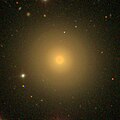| NGC 524 | |
|---|---|
 NGC 524 imaged by the Hubble Space Telescope | |
| Observation data (J2000 epoch) | |
| Constellation | Pisces |
| Right ascension | 01h 24m 47.7s [1] |
| Declination | +09° 32′ 20″ [1] |
| Redshift | 2403 ± 5 km/s [1] |
| Distance | 86.1 ± 13.7 Mly (26.4 ± 4.2 Mpc) [1] |
| Apparent magnitude (V) | 10.5 |
| Characteristics | |
| Type | SA(rs)0+ [1] |
| Apparent size (V) | 2.8′ × 2.8′ [1] |
| Other designations | |
| UGC 968, PGC 5222 [1] | |
NGC 524 is a lenticular galaxy in the constellation Pisces. It is at a distance of about 90 million light-years away from Earth. In the central bulge of the galaxy is visible gas forming a spiral structure. [2] It is the largest galaxy in the small NGC 524 group of galaxies, which is associated with NGC 488 and its group. [3] It was discovered by William Herschel on 4 September 1786. [4]

